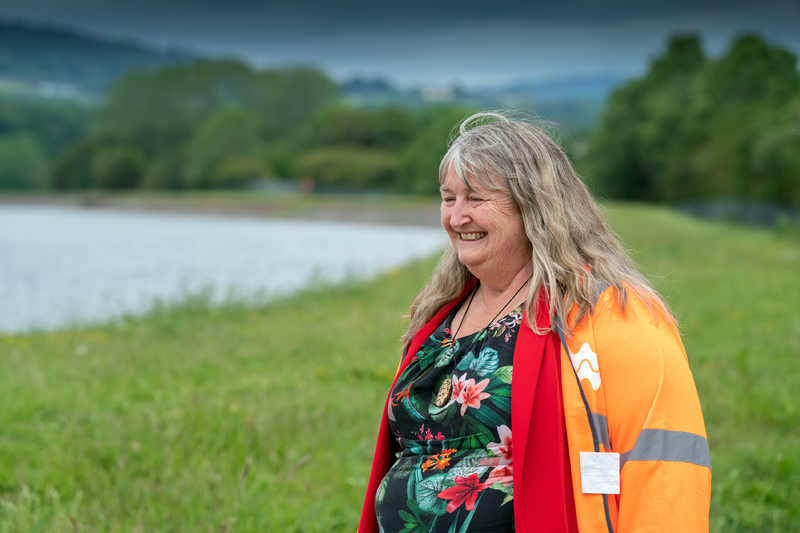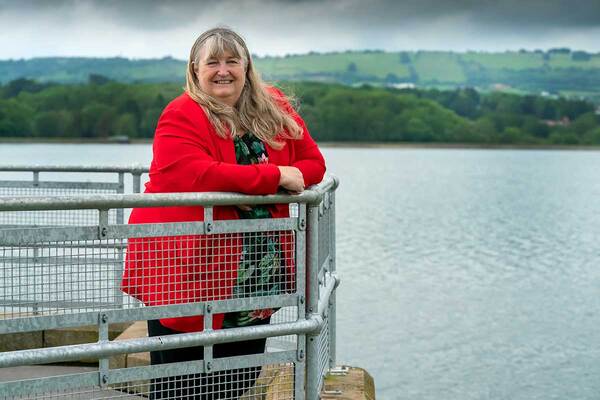Wales’ 20,000 social rent target will ‘be touch and go, but we’ll still make it’ – minister
Can the Welsh Labour government make good on its pledge to build 20,000 social homes by mid-2026? Jenny Messenger talks to Julie James, the Welsh government’s cabinet secretary for housing, local government and planning. Photography by Patrick Olner
Can the Welsh government meet its target to build 20,000 homes for social rent by 2026? So far, the government has delivered just over a quarter of that target – 5,775 homes – which is set against the current Senedd term of 2021 and 2026.
For the moment at least, Julie James, the Welsh government’s cabinet secretary for housing, local government and planning, is optimistic.
“We could still make it. It’ll be touch and go, but we’ll still make it,” Ms James says. “But that’s just a political cycle – the real point is, we need the houses. If we don’t make the target by three months, it’s not the end of the world in my view. It is about trying to push the industry into building the houses we need.”
Ms James is speaking to Inside Housing in the Welsh government’s office buildings in Cathays Park, north of Cardiff’s city centre. We’re in the room next door to where first minister Mark Drakeford held his COVID-19 briefings at a podium flanked by two Welsh flags.
“It’s an ambitious target. When we started, it was in 2021, of course, in the middle of the pandemic, and we honestly thought the pandemic was going to be the worst of our troubles. Actually, it hasn’t been,” Ms James says, citing supply chain shortages, cost of living increases and inflationary pressures.
“We think that we’re kind of hanging on to it by the skin of our teeth,” she reiterates, echoing phrasing she has used before.
“I’m not prepared to lower it, because once we do that, I’m a bit afraid that all of our registered social landlords and stockholding councils will go…” she mimics breathing a sigh of relief. “I don’t want them to do that.”
Will she get behind Inside Housing’s Build Social campaign, which is calling for political parties to commit to an annual target of 4,000 social rent homes a year in Wales over the next decade?
“I absolutely support the campaign,” she says, but cautions that the government has purposefully not set an annual target.
She says: “It’s really hard to meet an annual target. You need to look at how long it takes to get from the idea of the house to the house.”
Ms James says the government has done a lot of work on “the planning system, the supply chain and the construction industry”.
“You can’t just snap your fingers and build houses, with the best will in the world and wanting to build as many as possible. You have to have a ready workforce, the ability to skill them up, the supply chain in place, the land, the utilities – the actual house is the least of it,” she says.
Not all the 20,000 of her government’s target will be new builds. Some will be empty homes brought back into use, she adds.
“We work right down to individual site level with our local authority planning authorities to understand what’s in planning at the moment and whether there are enough houses, because if they’re not in planning now, we won’t get them built,” she says.
Because of this, the current development trajectory is “OK”, she says. “We would expect it to start slowly and build up at the end.”
Rethinking approaches to homelessness
But the need for new social homes is only getting more severe. The levels of homelessness in Wales are “growing, not declining”, Ms James says, with record numbers of people seeking help from homelessness services.
The Welsh government’s most recent figures show 11,692 people were being housed in temporary accommodation at the end of March 2024. More than 3,700 are housed in B&Bs and hotels.
An extensive piece of legislation is due to change Wales’ approach. A white paper on ending homelessness in the country was published in November 2023, with a bill set to be introduced into the Senedd in February 2025.
The proposals put forward are rooted in consultation with people with lived experience of homelessness and aim to switch the focus more to earlier interventions in the causes.
“We’ve been trying to move the budget from the sharp-end side to the preventative side. The analogy everyone uses is to try and turn the tap off, because at the moment, we’re filling a sink with the plug out,” Ms James says.
Wales is scrapping tests applied by local authorities to assess people on the basis of “priority need”, whether a person is “intentionally homeless” and if they have a local connection to the area.
The aim, the government says, is to make sure homelessness is rare, brief and unrepeated, enable rapid rehousing, and make preventing homelessness the responsibility of the entire Welsh public service.
In Cardiff alone, there are currently over 8,000 people on the housing waiting list and hundreds being housed in B&Bs or hotels. Waiting lists for temporary accommodation in Cardiff have leapt by 150% since 2021, despite more housing being made available.
In December 2023, Cardiff Council’s cabinet declared a housing emergency in the city due to “unprecedented pressures” on homelessness services.
One solution the city is trying out, is to take advantage of the ‘meanwhile’ use of a vacant site to bring in modular homes for temporary accommodation. This model uses permitted development rights, which means a project does not require planning permission and work can start far sooner.
One site is on the former gasworks in Grangetown, a district in the south of the city. In sight of IKEA and the delicate gas holder that gives the site its name, the 155 modular homes are all built to zero-carbon, Passivhaus standards, with photovoltaic panels and air source heat pumps.
Crucially, the homes are demountable, meaning that one day they could be moved to a permanent location. The Gasworks site will later have around 500 permanent mixed-tenure homes.
“It slightly sounds like we’ve put people in a shed, but they aren’t at all. They’re really very nice,” Ms James says. “I think that’s been quite a game-changer, but we still want to get them into their forever homes.”
Despite the issues clouding the use of modern methods of construction, Cardiff Council hopes to roll even more modular homes via vacant development sites, funded in part by the Welsh government’s Transitional Accommodation Capital Funding Programme for the modular homes.
At the end of May, the cabinet approved recommendations to buy two commercial properties to be converted for residential use to deliver 99 new homes. A nearby vacant site would allow it to “rapidly expand” the modular homes programme “to create around 150 homes for temporary or long-term family accommodation”.
As yet, though, hotels remain necessary and their use as temporary accommodation was approved for another 12 months.
“We’ve done quite a bit of work around Wales on attitudes to social housing,” Ms James adds.
“Most people immediately tell you that they don’t want social housing near their home. But once you dig below that a little bit, it’s because they don’t think they’ll ever get it,” she explains, because the demand is so high.
“As soon as you talk to them about having other allocation policies, like local connections, local work, people have a very different attitude to it.”
Wales in numbers
1,344
Homeless people placed into temporary accommodation during March 2024
11,692
Total number housed in temporary accommodation as at 31 March 2024
3,792
People housed in bed and breakfasts and hotels
645
Homeless people that were moved into long-term accommodation in March 2024
133
People estimated to be sleeping rough throughout Wales as at 31 March 2024
1,203
New build homes completed by social landlords in 2022-23
Guaranteeing funding
An ongoing concern among many in the sector is whether new standards and parcels of funding introduced by the government can be counted on in the long term.
The Housing Support Grant (HSG), a government scheme that funds the majority of homelessness and housing-related support services in Wales, is one example.
After fierce campaigning from bodies like Cymorth Cymru and Community Housing Cymru, the Welsh government announced an extra £13m for the HSG in 2024-25.
This funding is meant to go directly to uplifting frontline workers’ pay to make sure they are paid the Real Living Wage and, in some cases, the minimum wage, but without certainty that the money will be in the grant next year, some local authorities are worried they will be left spending more without the grant to back it up.
“I’m not sadly in a position yet to say whether we can baseline that to make sure it happens next year. We won’t know that until into the autumn this year,” Ms James says.
“But I will certainly be doing my level best to baseline it so that it doesn’t go back down to where it was before. It’s not a one-off payment.”
“It’s a really difficult conversation because the budget has been the worst budget I’ve ever lived through, and I’ve been doing this for a long time,” she adds, a situation stemming from the ongoing effects of high inflation and a constrained budget from Westminster.
The new Welsh Housing Quality Standard (WHQS) has also been a cause for concern among local authorities and housing associations because of the scale of retrofit required.
Under the standard, social landlords must aim to achieve Energy Performance Certificate (EPC) Band A for each property, but this will be done in steps, with an aim for EPC Band C by 2029.
Each home will have an Environmental Impact Rating informed by the average carbon emissions of the home, with higher scores for renewable heating systems and renewable technologies.
On the WHQS, Ms James says: “We’ve agreed the outcome, but what we haven’t agreed is the journey.
“We don’t really know, for every single type of house that we need to get to that standard, what needs to be done to that house.”
Housing associations and stockholding councils have been asked to carry out a survey of their properties over three years. “At the end of that, we will have a much better idea of what we’re talking about in real terms,” Ms James says.
As with the 20,000 homes target, Ms James is calmly confident.
“The last time we did this, we gave them five years to get to EPC Band D and absolutely everybody, I remember it very well, said that that could not be done. And we did do it,” she says.
These are goals that can be met, even if they are challenging, she suggests.
“I don’t like targets that are not possible to meet,” Ms James says. “I like targets that you could meet if you really put your back into it.”
Inside Housing political interviews
In the first week of June, we ran a number of political interviews, with politics high on the agenda in the lead-up to the general election and following the recent mayoral elections. Below is a list of articles published:
Liberal Democrats – we want to build 150,000 social homes a year
The Lib Dems back Build Social – and want to build even more social homes. Stephen Delahunty talks to Helen Morgan, the party’s housing spokesperson
Greens call for new role for councils in buying empty and ex-PRS homes
Green Party leader Carla Denyer talks to Grainne Cuffe about how the party proposes to tackle the housing crisis, while focusing on empty homes and added purchasing power for councils
The North East’s new mayor sets out her ambitions for social housing
Labour’s Kim McGuinness was elected as the first-ever mayor of the North East in May, and social housing is top of her agenda. Martin Hilditch finds out what she is calling for from housing associations, councils and her own party
Wales’ 20,000 social rent target will ‘be touch and go, but we’ll still make it’ – minister
Can the Welsh Labour government make good on its pledge to build 20,000 social homes by mid-2026? Jenny Messenger talks to Julie James, the Welsh government’s cabinet secretary for housing, local government and planning
Sign up for our Wales newsletter
New to Inside Housing? Click here to register and receive our Wales round-up straight to your inbox
Already have an account? Click here to manage your newsletters












